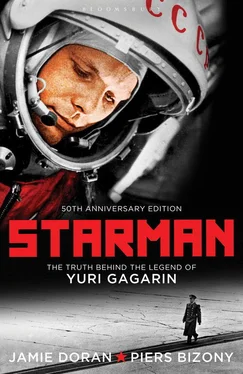Today, Russian capsules come down onto the vast (and supposedly uninhabited) steppes of Kazakhstan, not far from where they lifted off in the first place. A well-rehearsed procedure for capsule location and crew retrieval has operated for three decades. Back in 1961, Korolev and his mission planners were not quite so ready to dump their very first cosmonaut into the middle of nowhere. Gagarin fell to earth only a short distance from where he had first flown an old Yak-18 at the Saratov AeroClub six years earlier. The exact location of his touchdown was twenty-six kilometres south-west of the town of Engels in the Saratov region, on the outskirts of a village called Smelkovka.
From ground level there was no possibility of observing the ball’s hatch flying away, or the sudden jolt of Gagarin’s ejection seat. At seven kilometres’ altitude, this was all happening too high up to be seen. But tractor driver Yakov Lysenko heard a distinct crack in the skies above his head. Naturally he looked up. The faint echo of the hatchway’s explosive bolts took twenty seconds to reach him. By that time Gagarin and his craft had fallen three kilometres closer to the ground, and their parachutes had opened. They were just about visible now to the naked eye. In fact, it is probable that Lysenko heard a different bang closer to the ground, when the ball’s parachute hatch was blown off at just four kilometres’ altitude to deploy the folded canopy from within. ‘You can hear an explosion if it’s a plane or something like that, but I saw there was no plane,’ says Lysenko. ‘There was no engine roar. I was standing and watching, and I saw a ball in the air. Well, not a ball, but something landing with a parachute. A pilot from a plane, I thought.’
Lysenko ran back to Smelkovka village to raise the alarm. He gathered together a reassuring group of friends, and they all tramped across the fields to the spot where he had seen the ‘pilot’ come down. Gagarin seemed very happy to encounter ordinary folk like them. ‘We came to the place, and he was coming towards us. He was very lively and happy, especially after he landed successfully. He was wearing a jump-suit or whatever it’s called, and he said, “Boys, let’s be acquainted. I am the first space man in the world, Yuri Alexeyevich Gagarin.” He shook hands with everyone. I introduced myself, and he said, “Boys, don’t leave. All the bosses will be here any minute now. They’ll come by car, lots of people, but don’t leave. Let’s take a picture so we’ll remember this.” But of course everyone forgot about us. They came from a city or a military garrison. They took him into a car straight away. He told us not to leave, but they drove him away, and we’ve never seen him since.’
The official reception party arrived with terrifying speed, as if out of nowhere. General Stuchenko (his head still at risk) had been monitoring the skies all morning with close-range radar. Gagarin and his re-entry capsule were located long before they hit the ground, and Stuchenko disbursed his forces accordingly. ‘The military came by plane. Some of them were even landing by parachute,’ Lysenko recalls. ‘It was a complete invasion force. They didn’t allow us to get too close. They’re very strange people, you know.’
Lysenko may not be a sophisticated man – he’s just a simple tractor driver – but his grasp of the geopolitical significance of what he saw that day makes for a fine summary. ‘The Soviet Union announced a spaceship, the first in the world, with Yuri Alexeyevich Gagarin. The whole country was rejoicing. You know, it was a shame to the foreign countries. America is a mighty country, but they didn’t quite make it to be first. As they say, “It’s important who crosses the bog first.” That’s how I understand it.’
Lysenko and his friends were not the only people to see the cosmonaut come down, as Gagarin’s sanctioned account of his landing makes clear:
Stepping onto firm ground again, I caught sight of a woman and a little girl standing near a dappled calf and looking curiously at me. I was still in my bright-orange spacesuit, and they were a bit frightened by its strangeness. ‘I’m a friend, comrades! A friend!’ I shouted, taking off my helmet and feeling a slight shiver of nervousness. ‘Can it be that you have come from outer space?’ the woman asked. ‘As a matter of fact, I have!’ I replied. [1] Quoted in Golovanov, Our Gagarin , p. 150.
A slight shiver of nervousness . Everyone in the Soviet Union knew about the American spy Gary Powers, who had been shot down over Russian territory the previous May. Maybe this orange-clad pilot was yet another foreign spy parachuting from his stricken aircraft? A number of Western aerospace historians believe that some of the farm workers came at Gagarin with raised pitchforks, only standing down their weapons when they caught sight of the big red letters ‘CCCP’ emblazoned on the upper front of his white space helmet. Today the Soviet space journalist Yaroslav Golovanov is prepared to admit that ‘when they saw Gagarin’s orange protective suit, the women became frightened, because there was all this business about Powers only a year before. They said, “Where are you going? Where are you off to?” They thought maybe he was a spy.’
TASS radio announcements of the flight had been broadcast well in time for Gagarin’s actual descent. In all likelihood the farm workers greeted him with nervousness at first, but not with outright hostility. It may be that some of them had left their houses early that morning to go to work in the fields and may not have heard the radio bulletins about the space flight…
So who exactly had the opportunity to greet the cosmonaut first? Was it Lysenko and his pals, or the woman and child whom Gagarin spoke of? ‘Oh, I forgot about that,’ says Lysenko. ‘Yes, when we went to where he landed, Takhtarova, the local forest warden’s wife, was weeding potatoes with her grand-daughter. They had a small piece of cultivated land nearby. When he landed, we were not there. She was scared, and wanted to run away. Then he saw us.’
Later that day a simple signpost was erected at this site, more or less where Gagarin’s feet had touched the ground:
DO NOT REMOVE!
12.04.1961
10.55 MOSCOW TIME
Two days later a more permanent stone obelisk was erected bearing a plaque: ‘Y.A. Gagarin Landed Here.’ No similar marker identified the place where his empty spaceship came down. Gagarin’s ejection at high altitude had caused him and his capsule to drift apart by more than two kilometres by the time they hit the ground. Contemporary documentation blurs the whole issue. Recording the capsule’s landing site would have meant admitting the forbidden secret of the First Cosmonaut’s separate descent under his own parachute. However, the exact site is known – unofficially at least – because a group of children playing in a meadow near the banks of a tributary of the River Volga saw the empty ball come down, alarmingly close to a ditch. It made a dent in the soft ground. Today that hollow looks like a thousand similar indentations in the gentle surrounding grasslands.
Two schoolgirls, Tamara Kuchalayeva and Tatiana Makaricheva, ran over to see this amazing object. ‘We were supposed to be in a lesson at school, but all the boys ran off. They saw a ball flying,’ says Tatiana. ‘It was huge. It fell down, then bounced and fell down again, settling on its side. There was a large hole [in the ground] where it fell for the first time. The boys ran to it and climbed inside. They picked up many small tubes of cosmonauts’ food and brought them back to school, and they told us the ball had landed.’ The two fit, handsome women are mildly surprised that their nostalgic hike across the hillocks and furrows to see the landing place now makes for quite a sturdy walk. ‘Today we come here and are already tired, but at that time you can imagine how fast we children ran!’ says Tamara. ‘We’d heard the radio announcement and we all ran with inspiration.’
Читать дальше












